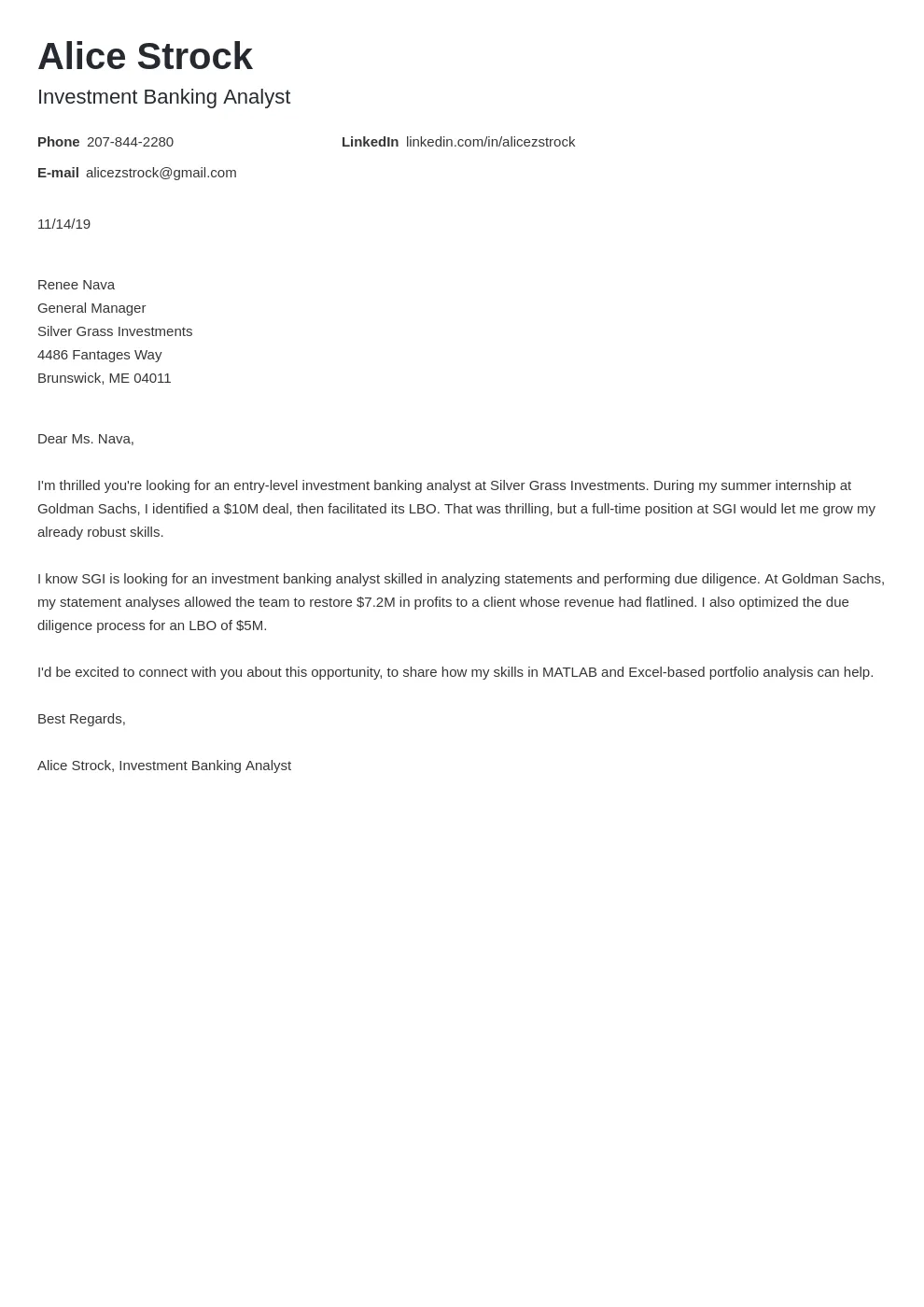Crafting the Perfect Investment Banking Cover Letter
Securing an investment banking internship is highly competitive. A well-crafted cover letter is your initial opportunity to make a strong impression and distinguish yourself from countless other applicants. It is not merely a formality but a crucial tool for showcasing your qualifications, demonstrating your understanding of the industry, and expressing your genuine interest in the specific role and the firm. A compelling cover letter can be the deciding factor in whether you secure an interview or your application is overlooked. Therefore, it’s crucial to approach this document with meticulous attention to detail and a strategic mindset. The key is to present yourself as a strong candidate who not only possesses the required skills but also aligns with the bank’s culture and values.
Understanding the Internship Application Process
The investment banking internship application process typically involves several stages. First, you’ll identify firms and open positions that align with your career goals. This involves researching the bank, the specific team or division you’re interested in, and understanding the internship requirements. Next, you’ll prepare your application, which usually includes a resume, cover letter, and sometimes transcripts or a writing sample. Submitting your application early is often beneficial, as many firms review applications on a rolling basis. After submitting, you might be invited for initial screening calls or online assessments. Successful candidates then proceed to in-person or virtual interviews, which may include behavioral, technical, and case study questions. Finally, if you impress, you’ll receive an offer, and hopefully, you will start your journey in investment banking. Understanding this process allows you to tailor each step effectively.
Researching Investment Banks
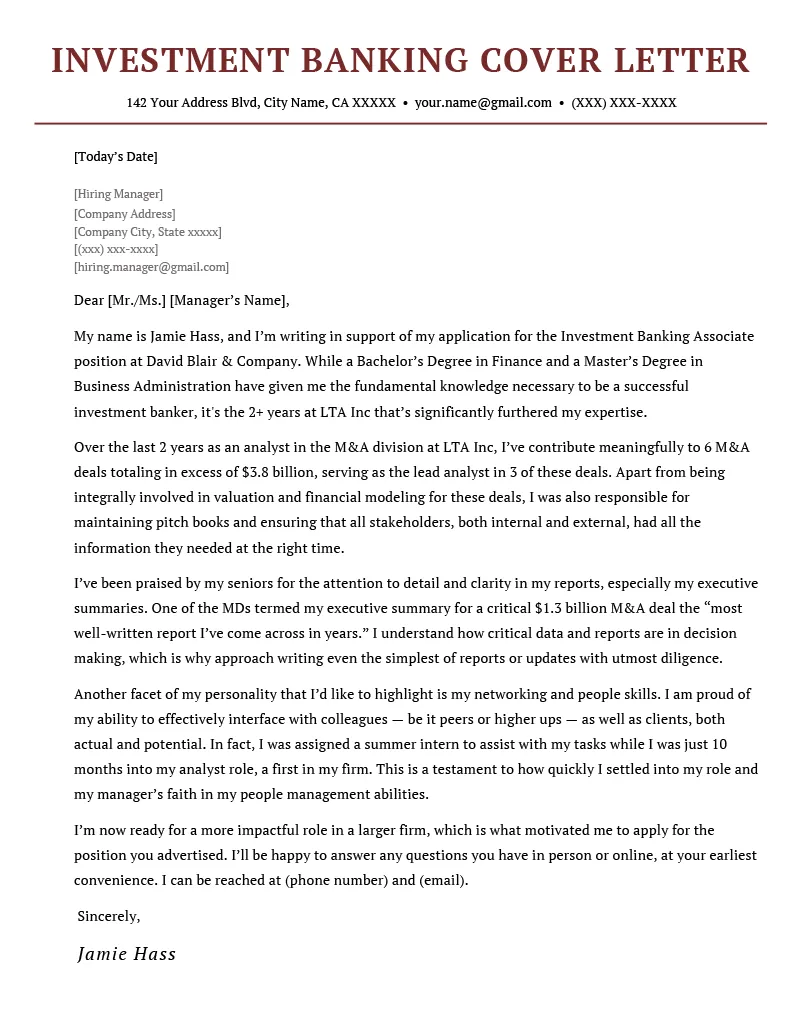
Thorough research into investment banks is vital. Before you start writing, explore the firm’s website, recent news articles, and financial reports. Understand their areas of focus, recent deals, and company culture. Identify the specific team or division you’re targeting and learn about their work. Showcasing your knowledge of the bank demonstrates genuine interest and helps you tailor your cover letter. Many banks have specific values or initiatives; incorporating those into your letter will make you stand out. Look for recent press releases, annual reports, and information about their leadership. Researching the specific individuals you might be working with or reporting to will further demonstrate your dedication. Your goal is to show you are not just applying anywhere but are genuinely interested in this firm and this specific role.
Highlighting Your Skills and Experiences
Your cover letter is where you bridge the gap between your resume and the role requirements. Focus on the skills and experiences most relevant to investment banking. Include financial analysis, modeling, valuation, and any related coursework or projects. Highlight your experience with Excel, financial databases (e.g., Bloomberg, FactSet), and programming languages (e.g., Python) if applicable. If you have relevant internship or work experience, describe your responsibilities and accomplishments, emphasizing what you learned and the impact you made. Even if your experience isn’t directly in finance, highlight transferable skills such as analytical thinking, problem-solving, teamwork, and communication. Tailor the skills you mention to match the job description – understanding what they seek will let you align your skills in the cover letter.
Quantifiable Achievements
Instead of simply listing your responsibilities, provide specific examples of your achievements and quantify them whenever possible. Instead of saying “Managed projects,” say “Managed a team of 5 to complete a project, resulting in a 15% reduction in project completion time.” Instead of saying “Improved customer service,” say “Improved customer satisfaction scores by 20% through implementation of a new feedback system.” Numbers, percentages, and metrics are powerful tools to demonstrate the impact of your work. Use the STAR method (Situation, Task, Action, Result) to provide context and structure your examples. By highlighting specific achievements, you provide concrete evidence of your capabilities and give the reader a clear understanding of your skills.
Relevant Coursework and Academic Projects
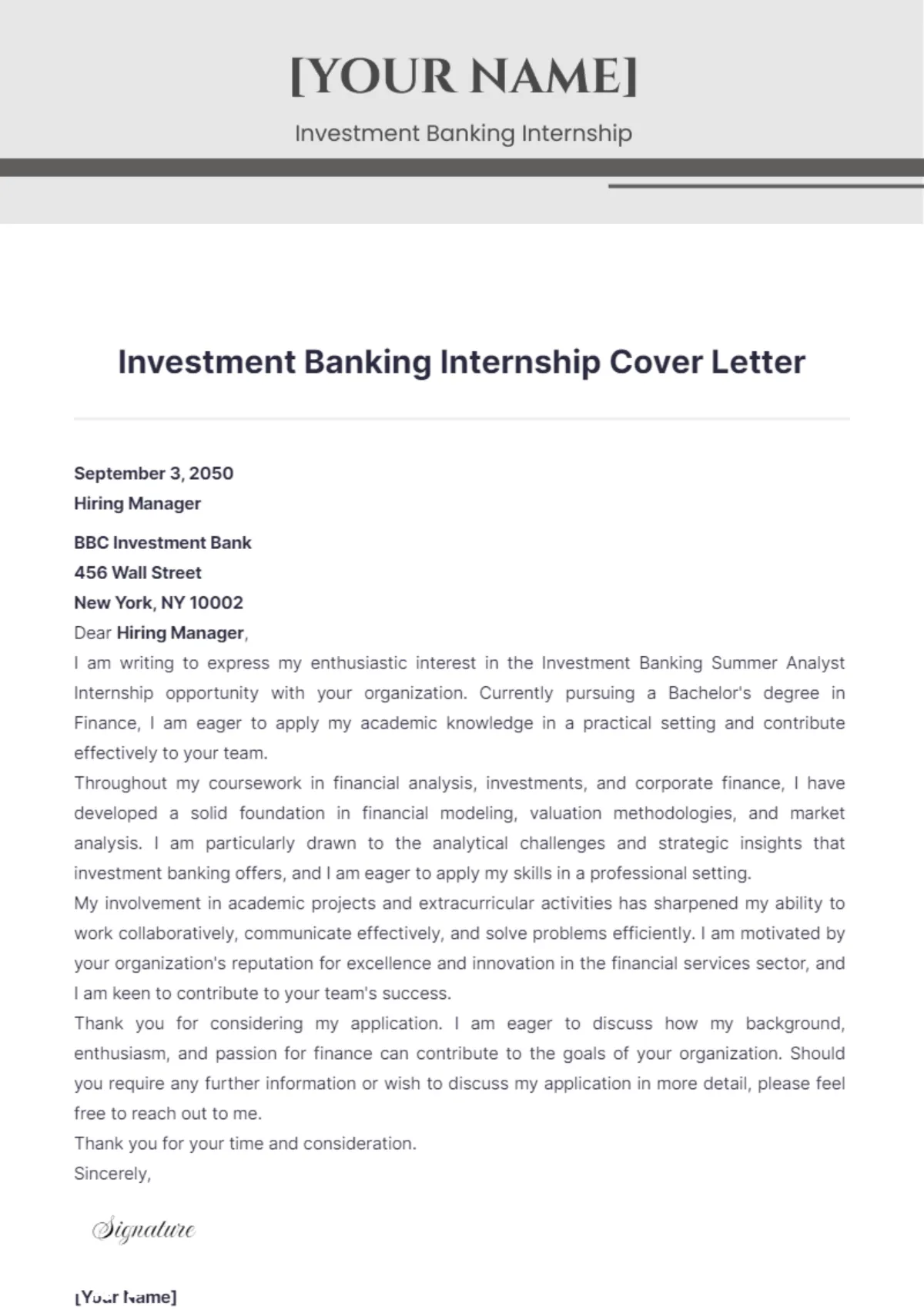
Showcase the relevant coursework and academic projects that demonstrate your understanding of finance and your analytical abilities. Mention courses like Financial Accounting, Corporate Finance, Investments, and Derivatives. If you have completed any finance-related projects (e.g., financial modeling, valuation analysis, market research), briefly describe them and highlight what you learned. Emphasize any skills you developed or tools you used during these projects, such as building financial models in Excel, using valuation techniques, or analyzing market trends. Even if the projects weren’t perfect, what counts is showing the interviewer how you can apply the theoretical knowledge of finance into practical scenarios. Be specific and show how your academic background prepares you for the demands of an investment banking internship.
Showcasing Your Passion for Finance
Demonstrate your genuine interest in finance and investment banking. Discuss your motivation for pursuing a career in this field. Explain what attracts you to investment banking specifically – the challenges, the fast-paced environment, and the opportunity to work on impactful deals. Mention any finance-related extracurricular activities, such as participation in a finance club, investment club, or case competitions. Show your understanding of current market trends and industry news. This shows you are interested in financial markets and is already doing your research on the subject. Articulate your long-term career goals and how an internship at this firm aligns with your aspirations. Passion is what drives success, make sure your letter reflects your zeal.
Tailoring Your Cover Letter
One of the most common mistakes is using a generic cover letter. Tailor your cover letter to each specific bank and position you’re applying for. Address the specific requirements and skills mentioned in the job description. Research the bank and mention specific deals, projects, or initiatives that resonate with you. Personalize your letter by addressing the hiring manager by name (if possible) and mentioning any connections you have to the firm (e.g., alumni, networking contacts). Generic cover letters lack impact and show a lack of interest. Show the potential employer that you are serious about a position by personalizing your letter and researching their needs and requirements.
Addressing the Specific Bank and Role
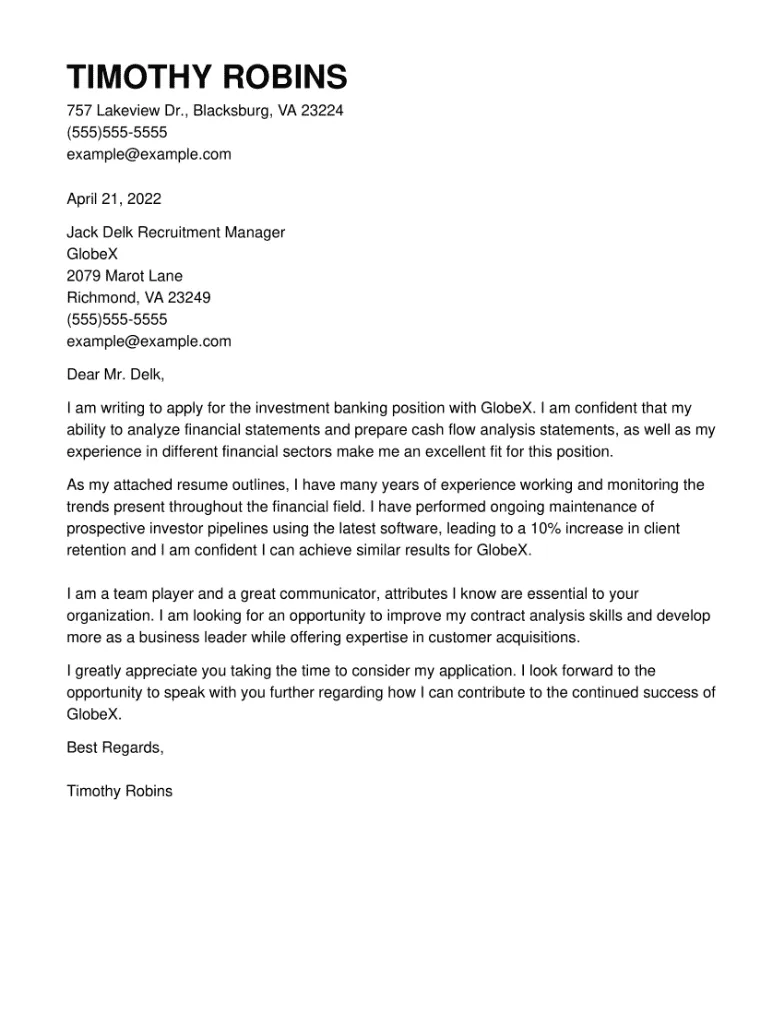
The key to a great cover letter is to demonstrate you’ve done your homework. Directly address the name of the bank and mention the specific role you’re applying for in the opening paragraph. Show that you understand the bank’s culture and values. If possible, mention specific projects or recent deals that the bank has been involved in, showing you have done your research. Talk about why you want to work in that specific role. By demonstrating your specific interest in this particular bank and position, you set your application apart from the rest.
Structuring Your Cover Letter
A well-structured cover letter is easy to read and conveys your message effectively. Use a clear and concise format with distinct paragraphs. Each paragraph should focus on a specific point, and the overall tone should be professional and engaging. Use strong action verbs, and avoid jargon. The structure of your cover letter should include an opening paragraph, several body paragraphs, and a closing paragraph. Each section has a clear purpose, such as introducing yourself, highlighting your skills and experience, and expressing your interest in the position.
The Opening Paragraph
The opening paragraph is your first chance to capture the reader’s attention. State the position you are applying for and how you found out about it. Briefly mention why you are interested in the role and the firm. If you have a referral, mention the connection. The opening should be concise and impactful. State your enthusiasm to work for the company and the particular team or group you are interested in. Make sure this paragraph shows your familiarity with the company and the key skills you offer. This opening sets the tone for the rest of the letter and encourages the reader to continue reading.
Body Paragraphs Demonstrating Fit
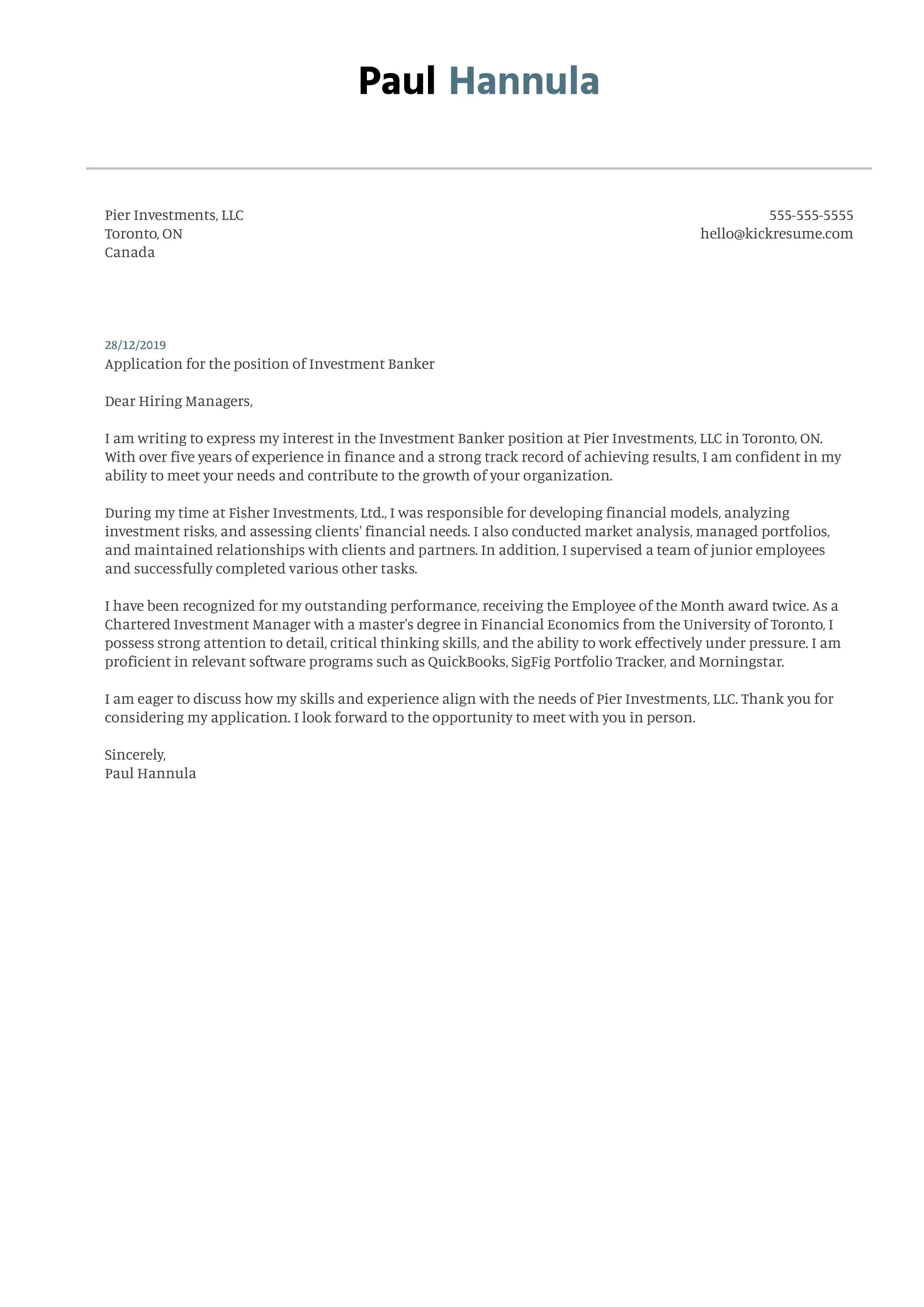
Use the body paragraphs to showcase your relevant skills, experiences, and achievements. Provide specific examples and quantify your accomplishments whenever possible. Explain how your skills and experiences align with the requirements of the job and the values of the firm. Show how your background makes you a good fit for the role. Use each paragraph to highlight different aspects of your qualifications and support the claims with evidence and stories. Each body paragraph should focus on a key point and illustrate the ‘why’ behind your interest and what you can offer to the potential employer.
The Closing Paragraph
In the closing paragraph, reiterate your interest in the position and express your enthusiasm to learn more. Thank the reader for their time and consideration. Include a call to action, such as stating your availability for an interview. Reiterate your passion for the role. Proofread the closing paragraph for any errors. Make sure that you end on a positive and enthusiastic note.
Proofreading and Editing
Proofreading and editing your cover letter is essential. Errors in grammar, spelling, and punctuation can damage your credibility and undermine your application. Read your cover letter carefully multiple times. Ask a friend, career counselor, or professor to review it for you. Pay attention to the formatting, and ensure the letter is easy to read. Make sure the tone is professional and the language is clear and concise. Correct any typos, grammatical errors, or formatting inconsistencies. A polished cover letter reflects your attention to detail and professionalism, which are critical traits for success in investment banking.
Common Mistakes to Avoid
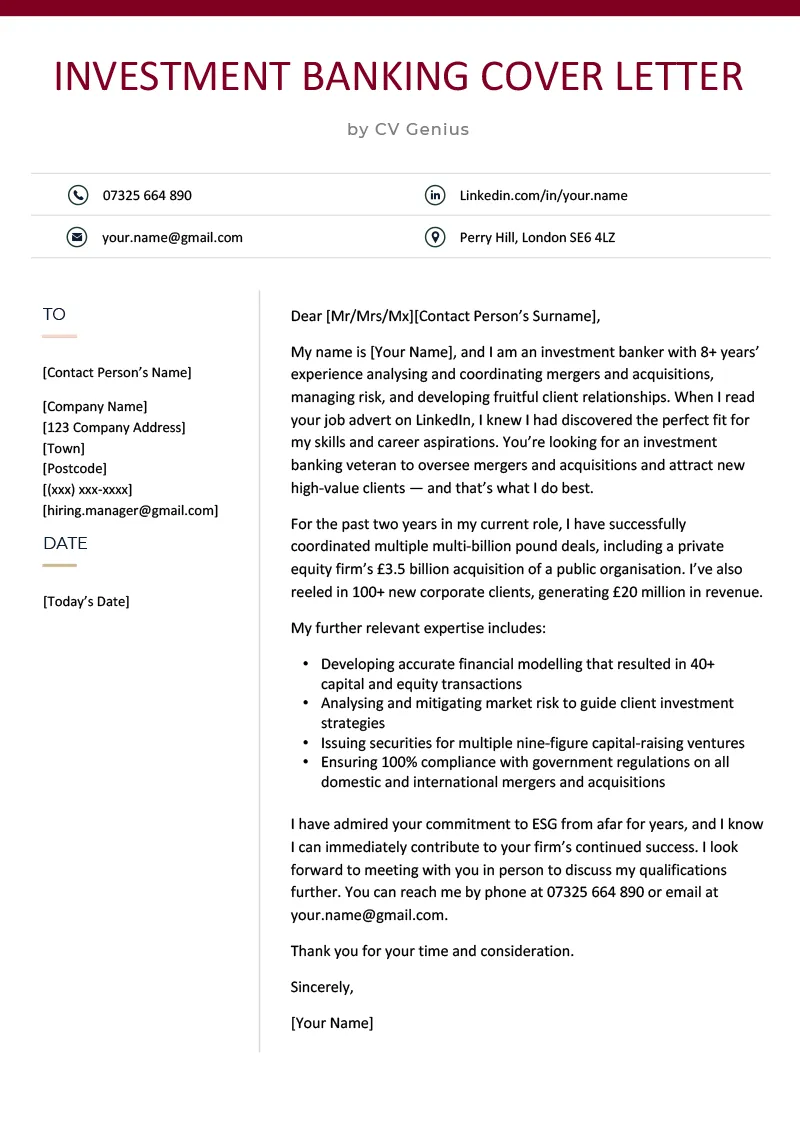
Avoiding common mistakes can significantly improve your chances of success. Being aware of these pitfalls can help you stand out from other candidates. Some mistakes can easily make or break an application, so being aware of these common errors is a crucial part of the process.
Generic vs Tailored Cover Letters
Submitting a generic cover letter is a surefire way to have your application rejected. A generic cover letter shows a lack of interest and effort, and hiring managers can easily spot them. Tailor your cover letter to each specific job, demonstrating that you’ve researched the firm and understand the role. Mention specific details from the job description and explain why you are the best candidate. Make sure the letter speaks directly to the specific requirements of the role.
Overstating Skills or Experience
Avoid exaggerating your skills or experience. Be honest and accurate in your cover letter. It is better to be truthful about your accomplishments than to make false claims that can easily be verified during the interview process. It is important to be genuine and authentic. When you are truthful about your experiences and skills, the employer will have a more realistic expectation, and you will be more likely to succeed if you get the job.
Lack of Proofreading
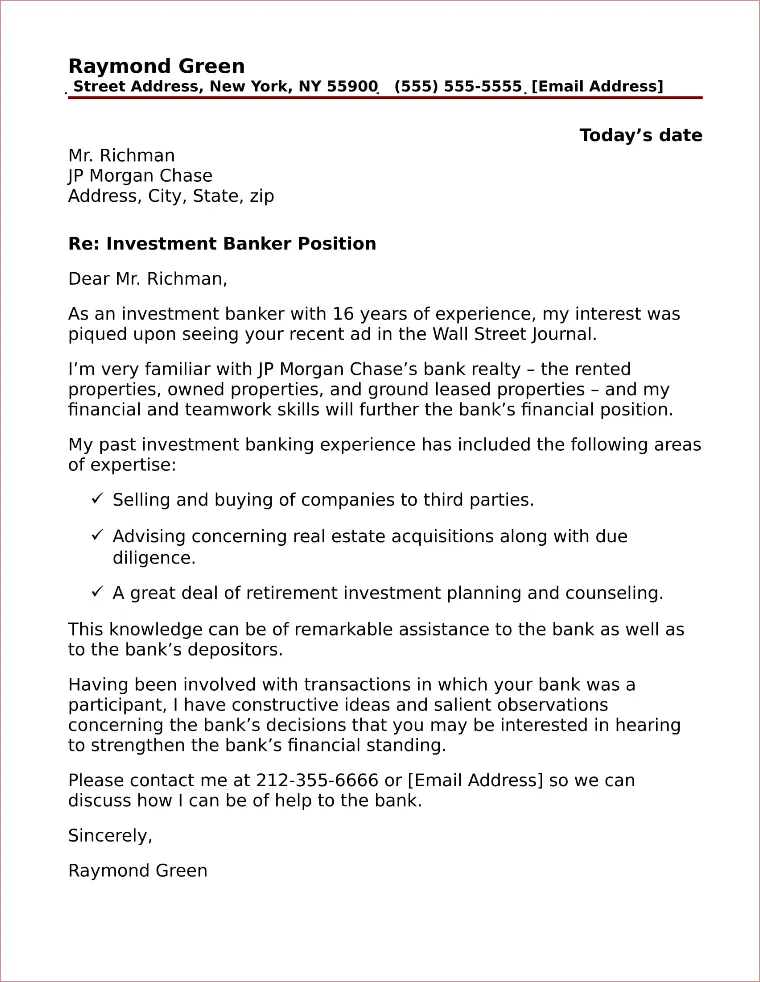
Failing to proofread your cover letter for errors is a major mistake. Errors in grammar, spelling, and punctuation can ruin your credibility and make it appear that you don’t pay attention to detail. Always proofread your cover letter multiple times, and consider having someone else review it. Make sure your formatting is consistent, and the letter is easy to read. Proofreading is an easy way to ensure your application is a success, so make sure to proofread before submitting.
Formatting and Presentation Tips
The formatting and presentation of your cover letter are just as important as the content. Use a professional and readable font, such as Times New Roman or Arial, with a font size of 11 or 12 points. Use clear and concise language, and avoid jargon or overly complex sentences. Use bullet points to highlight key skills or achievements and to make your letter easier to scan. Keep the letter concise, ideally no more than one page in length. The formatting and presentation make a crucial first impression, so make it count.
Using Action Verbs
Using strong action verbs can make your cover letter more dynamic and engaging. Instead of saying “Responsible for,” use verbs like “Managed,” “Led,” “Developed,” “Implemented,” or “Achieved.” These action verbs give the reader a clear understanding of your accomplishments and the impact you made. Start each bullet point or accomplishment with an action verb. Action verbs are a crucial part of a strong cover letter.
Font Choice and Readability
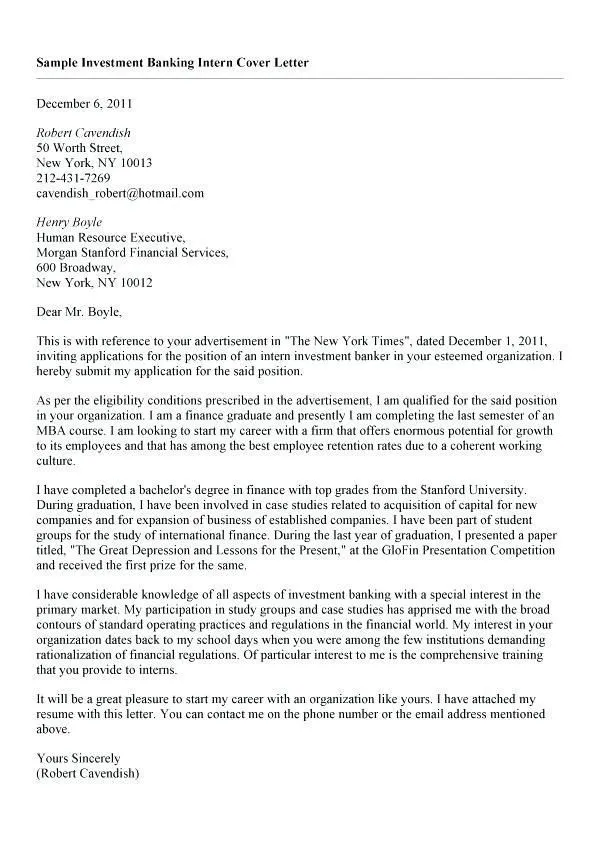
Choose a professional and readable font for your cover letter. Avoid using unusual or overly stylized fonts that can be difficult to read. Stick to classic and widely accepted fonts like Times New Roman, Arial, or Calibri. Ensure the font size is appropriate (11 or 12 points) for easy readability. Use appropriate margins, and spacing to create a clean and visually appealing layout. The readability is just as important as the words you use in the cover letter.
Submitting Your Cover Letter
When submitting your cover letter, follow the instructions provided by the employer carefully. If the job application is online, ensure that you upload the cover letter in the correct format (usually PDF or Word). If you’re sending your cover letter via email, use a professional email address and write a concise and professional subject line. Always proofread the email and any attachments before sending. Double-check the formatting to make sure everything looks correct, and make sure you have included all necessary documents. Follow the instructions to the letter – the cover letter is the first step.
Follow-Up Strategies
After submitting your cover letter, follow up with the hiring manager or recruiter to express your interest. However, be patient and avoid being overly persistent. Send a brief and polite email a week or two after submitting your application, thanking them for their time and reiterating your interest. Reiterate your interest, but don’t be overbearing. If you haven’t heard back after a reasonable amount of time, send a follow-up email or call to inquire about the status of your application.
Networking and Informational Interviews
Networking is an important part of the job search process. Attend industry events, connect with investment banking professionals on LinkedIn, and reach out to alumni from your university. Informational interviews can be helpful in learning more about the industry and building your network. During these interviews, ask questions about the firm, the role, and the hiring process. Networking is crucial. It allows you to show that you’re serious about investment banking. It helps you learn about the company and make valuable connections.
